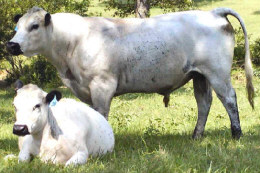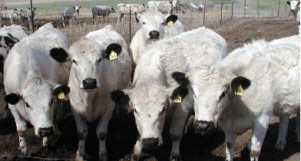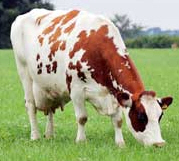



British White
History
The British White is one of the oldest breeds in Britain with direct links with the ancient indigenous wild white cattle of Great Britain. This breed originated from Whalley Abbey, Lancashire.In 1765 some of the original white polled cattle from this farm were taken down to Norfolk by Mary Assheton into Gunton Park. Gunton Park cattle are said to have been the foundations of two herds, one near Aylsham which not much is known about but became almost extinct by the plague in 1860, only two animals remained. From these two the herd was built up again to help in the foundation of many other herds.
The second herd founded from Gunton stock was that at Woodbastwick, established in 1840 by the purchase of one or two animals at a sale held by the fourth Lord Suffield. British white cattle are either red pointed or black pointed and in this herd red was preferred, the black being transfered to another herd (Blickling). However, by 1918 the universally dominant colour was black pointed, red points occurring at a similar low level of frequency as today.
 Photo courtesy of Halliburton Farms British White Cattle Breeders, www.britishwhite.com |
Another herd that contributed to this breed was the Somerford herd, Cheshire, which has been described as having cattle of an intermediate type between the horned and polled park cattle.
Between 1875 and 1918 general exchanges of bulls took place between Somerford and the herds at Woodbastwick and Northrepps (founded about 1890 with a bull from Woodbastwick and a cow from Blickling) thus the blood of all these founding herds was commingled. Through various herds there became two type of this breed (at the moment still referred to as Park cattle) horned and polled.
By the beginning of the twentieth Century there was an awareness that the outstanding and unique qualities of "Park Cattle" could best be conserved and promoted by the banding together of breeders. Sir Claud Alexander owner of the Faygate herd, writing in the Amateur Menagerie Club Year Book 1912 says "I would, however, strongly advise anyone who may think of forming a herd to go to the Polled variety for his foundation stock, for they have been kept from time immemorial for their milk and beef producing qualities, and right well do they justify their existence.... The Somerford cows are excellent milkers and one of mine averages five gallons a day when in full profit. In addition to this they are big heavy beasts and give a good return from the butcher when their milking days are over. Mr Quinton Gurney's herd at Northrepps Hall is a thoroughly practical one, for on it devolves the task of keeping the town of Cromer supplied with milk. At Woodbastwick too some grand milkers are to be found, and here great attention is paid to beef producing powers, as the records of the local fat stock shows frequently testify. If anyone who reads these notes and feels inclined to form a herd will communicate with me, I shall be pleased to supply any information that may be required".
And so, shortly afterwards in January 1918 the Park Cattle Society was formed "with the object of keeping records of Park Cattle, wild and tame, of developing and popularising their great commercial qualities as well as keeping up developing scientific interest in this most ancient race".
In 1946 the two forms of Park Cattle, Horned and Polled decided to split and administer their own affairs, and thus the British White Cattle Society evolved. From then on this breed has been known as British White.
For a considerable time the members of the Society had to struggle to maintain the breed in the face of very low numbers. However, in 1973 the RBST was formed and a growing awareness of the existence and desirability of rare breeds began to emerge. Due, no doubt, partly to this and partly to the increasing efforts of the British White Cattle Society interest in the breed began to rise markedly to the point where, in 1990 there were 116 herds containing over 1,500 registered cattle.
Characteristics
 Photo courtesy of Halliburton Farms British White Cattle Breeders, www.britishwhite.com |
This type of pigmentation and the black points elimintates problems of eye cancer and sunburn.
Mature cows weigh to 650 kgs and mature bulls to one tonne. British White are docile, hardy and remarkably free from disease. They are good milk producers and are equally well known for their beef qualities, the meat being of excellent texture.
Another quality of this breed is their mothering ability by individual females, also incorporating the nursery system of a guard cow protecting groups of calves whiles the remainder of the herd grazes. Although this characteristic is known in some breeds of cattle, it is highly developed in British Whites and is of great benefit in areas where wild dogs or other predators are a concern.
Statistics
Comparative
Distribution
 Photo courtesy of Halliburton Farms British White Cattle Breeders, www.britishwhite.com |
References (the above information was cited from the following sites)
www.britishwhitecattle.co.uk
www.britishwhiteaustralia.com
www.britishwhite.org


